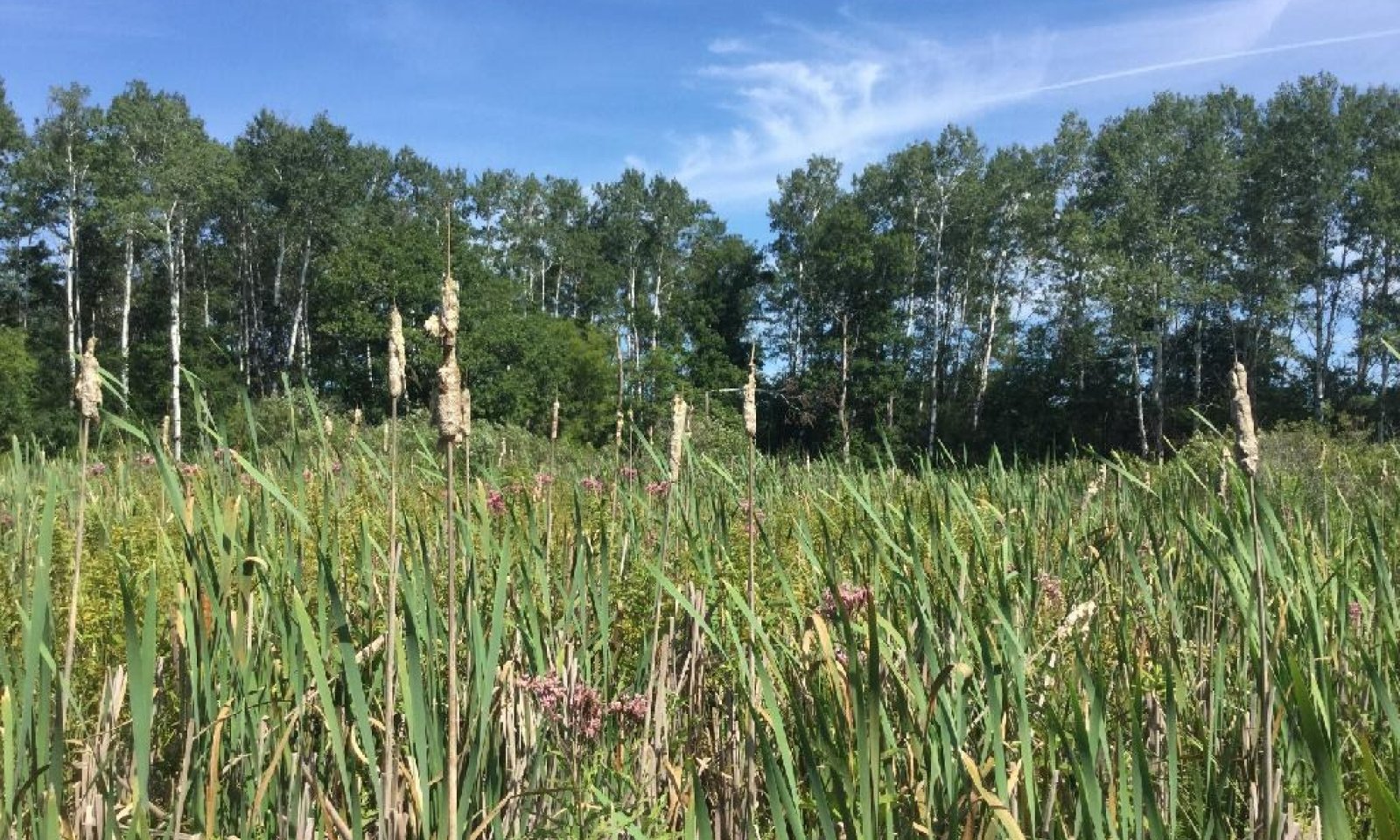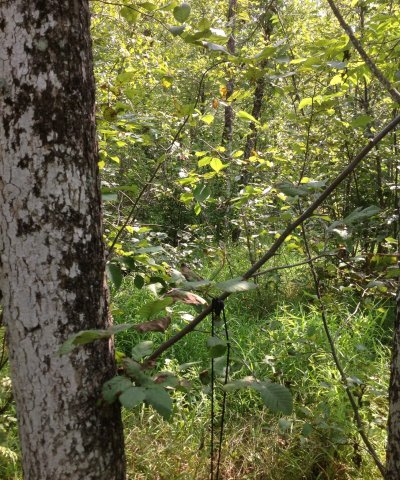

Natural Resources
Conservation Service
Ecological site F105XY001WI
Mucky Swamp
Last updated: 2/23/2024
Accessed: 12/22/2025
General information
Provisional. A provisional ecological site description has undergone quality control and quality assurance review. It contains a working state and transition model and enough information to identify the ecological site.
MLRA notes
Major Land Resource Area (MLRA): 105X–Upper Mississippi River Bedrock Controlled Uplands and Valleys
The Northern Mississippi Valley Loess Hills area corresponds closely to the Western Coulees and Ridges and Southwest Savanna Ecological Landscapes. Some of the following brief overview is borrowed from the Wisconsin Department of Natural Resources Ecological Landscape publication (2015).
Fifty-two percent of the Upper Mississippi River Bedrock Controlled Uplands and Valleys MLRA is in Wisconsin; Iowa, Minnesota, and Illinois contain the rest. This region is the only area in Wisconsin that has not been covered by glaciers within the past 2.4 million years. The Wisconsin portion of this MLRA is approximately 7.4 million acres (11,600 square miles). The landscape is characterized by dissected topography with deeply-incised, steep-walled valleys between bedrock controlled ridges.
Though it’s called the “Driftless Region”, some glacial drift is found in the major river valleys of this region in the form of outwash, deposited by proglacial streams of glacial meltwater. Wisconsin’s most recent glaciations also impacted the sediment of the area through the deposition of loess. After the glacier receded and before vegetation established, the bare surfaces of the glaciated areas were highly susceptible to wind erosion. As a result, a veneer of loess (wind-blown silt) was deposited over the entire region. The thickest deposits—nearly five meters—are on ridges near the Mississippi River and gradually thin moving eastward. The loess caps in Dane and Green counties are generally 0.5-1.5 meters deep. Much of the loess has eroded downslope and collected in floodplains.
Bedrock is shallow throughout this MLRA and is a major influence on topography and hydrology. Most of the MLRA has bedrock within two meters, except in the deep river valleys that are filled with outwash and alluvium materials. Sandstone is the dominant bedrock type in MLRA 105, but the southernmost portion is dominated by dolomite. Military Ridge is an escarpment that straddles the boundary between sandstone and dolomite bedrock. The sandstone north of the ridge is weaker than the erosion-resistant dolomite south of the ridge. The sandstone is deeply cut and dissected into steep slopes and valleys. The dolomite-controlled ridges tend to be less dissected and broader with more gentle, south sloping topography. Geomorphic and fluvial processes formed these landscapes by way of sheet wash, soil creep, and flowage. These processes eroded the hillslopes, cut into bedrock, and transported the debris to streams, forming floodplains and terraces.
Underfit streams are common in MLRA 105, especially in the southern portion. These streams currently occupy large river valleys—especially those of the Black, Chippewa, Mississippi, and Wisconsin Rivers—that were carved by proglacial meltwater streams carrying much larger quantities of water than what’s present today. As the climate dried, waterflow decreased and the valleys filled with alluvial sediment. Narrow meanders were formed by the shrinking streams and are often dissimilar to the meanders of the larger valleys they occupy. Fluvial landforms – including terraces, oxbow lakes, sandbars, eroding bluffs, and large floodplain complexes – are found within these large valleys and are subject to varying flooding frequencies, intensities, and durations.
Karst topography formed in this region from dissolution of carbonate bedrock by surface and groundwater. Dolomite and limestone are more easily affected by dissolution, but karst topography also formed in sandstone. Erosion by water (stream meanders, rain/runoff, and groundwater), wind, and frost weaken joints and bedding planes that can cause collapse. In addition, sandstone materials collapse into cavities in underlying dolomite or limestone.
Historically, MLRA 105 was dominated by oak forests and oak openings making up more than 50% of the area. Prairies were significant and covered 32% of the area south of Military Ridge. Maple-basswood forests covered 19% of the are north of Military Ridge. Dominant tree species were white oak (Quercus alba), bur oak (Quercus macrocarpa), black oak (Quercus velutina), and sugar maple (Acer saccharum).
Classification relationships
Relationship to Established Framework and Classification Systems:
Habitat Types of S. Wisconsin (Kotar, 1996): No habitat types exist for wetland forests in this area. When developed it is likely to be a Fraxinus nigra-Ulmus type.
Biophysical Settings (Landfire, 2014): This ES is largely mapped as Central Interior and Appalachian Swamp Forest, Central Interior and Appalachian Floodplain Forest, and Central Interior and Appalachian Shrub Wetlands
Hierarchical Framework Relationships:
Major Land Resource Area (MLRA): Upper Mississippi River Bedrock Controlled Uplands and Valleys (105)
USFS Subregions: Menominee Eroded Pre-Wisconsin Till (222La), Melrose Oak Forest and Savannah (222Lb), Mississippi-Wisconsin River Ravines (222Lc), Kickapoo-Wisconsin River Ravines (222Ld)
Wisconsin DNR Ecological Landscapes: Western Coulee and Ridges
Ecological site concept
The Mucky Swamps ecological site accounts for approximately 71,000 acres in MLRA 105, or about 1% of total land area. The sites are scattered throughout the MLRA in depressions and drainageways amid outwash plains, moraines, and loess hills. They form in low positions on the landscape where bedrock is deep. The soils are very deep and very poorly drained and are characterized by deep organic deposits of primarily herbaceous origin. Precipitation, runoff from adjacent uplands, stream inflow, and groundwater discharge are the primary sources of water. These soils remain saturated throughout the year and meet hydric requirements.
Associated sites
| F105XY002WI |
Wet Sandy Floodplain These sites form in deep, sandy alluvium and outwash deposits in floodplains, especially those along the Chippewa, Black, and Wisconsin rivers. They support vegetation tolerant of seasonal flooding. They are sometimes saturated enough for hydric conditions to occur. These sites are sometimes wetlands and may sometimes host ecological communities similar to those supported by Mucky Swamps. |
|---|---|
| F105XY003WI |
Wet Loamy-Clayey Floodplain These sites form in deep, loamy alluvium deposits along floodplains, especially those along smaller tributaries to the Chippewa, Black, and Wisconsin rivers. They support vegetation tolerant of seasonal flooding. They are sometimes saturated enough for hydric conditions to occur. These sites are sometimes wetlands and may sometimes host ecological communities similar to those supported by Mucky Swamps. |
| F105XY004WI |
Wet Sandy Lowland These sites form in depressions and drainageway in deep, sandy outwash deposits. They are very poorly or poorly drained and are saturated long enough for hydric conditions to occur. Like Mucky Swamps, they often occupy landscape depressions and host vegetation tolerant of prolonged periods of wetness. |
| F105XY005WI |
Wet Loamy-Clayey Lowland These sites form in depressions, drainageways, and swales in deep loamy alluvium deposits or in clayey residuum. They are very poorly or poorly drained and are saturated long enough for hydric conditions to occur. Like Mucky Swamps, they often occupy landscape depressions and host vegetation tolerant of prolonged periods of wetness. |
Similar sites
| F105XY002WI |
Wet Sandy Floodplain These sites form in deep, sandy alluvium and outwash deposits in floodplains, especially those along the Chippewa, Black, and Wisconsin rivers. They support vegetation tolerant of seasonal flooding. They are sometimes saturated enough for hydric conditions to occur. These sites are sometimes wetlands and may sometimes host ecological communities similar to those supported by Mucky Swamps. |
|---|---|
| F105XY003WI |
Wet Loamy-Clayey Floodplain These sites form in deep, loamy alluvium deposits along floodplains, especially those along smaller tributaries to the Chippewa, Black, and Wisconsin rivers. They support vegetation tolerant of seasonal flooding. They are sometimes saturated enough for hydric conditions to occur. These sites are sometimes wetlands and may sometimes host ecological communities similar to those supported by Mucky Swamps. |
| F105XY004WI |
Wet Sandy Lowland These sites form in depressions and drainageway in deep, sandy outwash deposits. They are very poorly or poorly drained and are saturated long enough for hydric conditions to occur. Like Mucky Swamps, they often occupy landscape depressions and host vegetation tolerant of prolonged periods of wetness. |
| F105XY005WI |
Wet Loamy-Clayey Lowland These sites form in depressions, drainageways, and swales in deep loamy alluvium deposits or in clayey residuum. They are very poorly or poorly drained and are saturated long enough for hydric conditions to occur. Like Mucky Swamps, they often occupy landscape depressions and host vegetation tolerant of prolonged periods of wetness. |
Table 1. Dominant plant species
| Tree |
(1) Fraxinus nigra |
|---|---|
| Shrub |
(1) Alnus incana |
| Herbaceous |
(1) Carex |
Click on box and path labels to scroll to the respective text.
Ecosystem states
State 1 submodel, plant communities
| 1.1A | - | Ponding frequency and duration increase. |
|---|---|---|
| 1.1B | - | Ponding frequency and duration increase dramatically. |
| 1.2B | - | Very infrequent ponding. |
| 1.2A | - | Ponding frequency and duration increase moderately. |
| 1.3A | - | Ponding frequency and duration decrease. |

